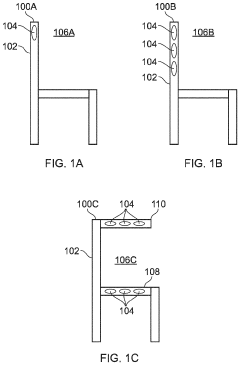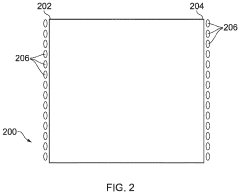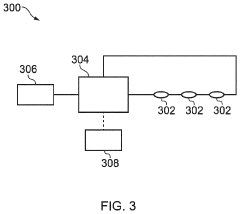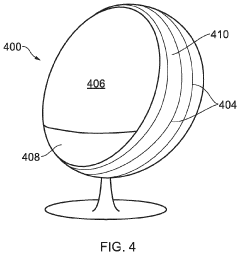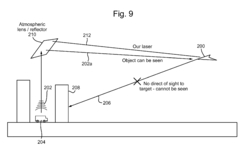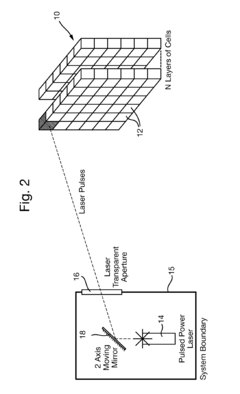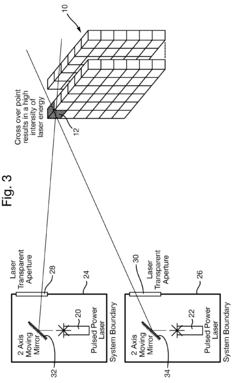How to Incorporate Schumann Resonance into Remote Sensing?
JUN 24, 20259 MIN READ
Generate Your Research Report Instantly with AI Agent
Patsnap Eureka helps you evaluate technical feasibility & market potential.
Schumann Resonance Background and Remote Sensing Goals
Schumann resonance, discovered by physicist Winfried Otto Schumann in 1952, refers to the natural electromagnetic frequencies occurring in the Earth's ionosphere cavity. These resonances, primarily at 7.83 Hz and its harmonics, are generated by global lightning activity and have been a subject of scientific interest for decades. The integration of Schumann resonance into remote sensing represents a novel approach to enhancing our understanding of Earth's electromagnetic environment and its potential applications in various fields.
The evolution of Schumann resonance research has seen significant advancements since its discovery. Initially studied for its potential impact on weather patterns and human health, recent technological developments have opened new avenues for its application in remote sensing. The growing interest in this field is driven by the unique properties of Schumann resonances, which offer global coverage and penetration through various media, making them potentially valuable for Earth observation and environmental monitoring.
The primary goal of incorporating Schumann resonance into remote sensing is to develop innovative techniques for monitoring global phenomena. This includes tracking lightning activity, studying ionospheric dynamics, and potentially detecting seismic activities. By leveraging the global nature of Schumann resonances, researchers aim to create more comprehensive and continuous monitoring systems that can provide insights into large-scale atmospheric and geophysical processes.
Another significant objective is to enhance existing remote sensing methodologies. Schumann resonance data could complement traditional satellite and ground-based observations, offering a new dimension to Earth observation techniques. This integration aims to improve the accuracy and reliability of various environmental and geophysical measurements, potentially leading to better climate models and weather prediction systems.
Furthermore, the incorporation of Schumann resonance into remote sensing seeks to explore new applications in fields such as natural disaster prediction, electromagnetic pollution monitoring, and even space weather forecasting. The unique characteristics of these resonances, including their stability and global presence, make them an attractive option for developing novel sensing technologies that can operate on a planetary scale.
As research in this area progresses, the technical challenges of accurately measuring and interpreting Schumann resonance signals in the context of remote sensing are being addressed. This includes developing more sensitive detection equipment, improving signal processing techniques, and creating sophisticated algorithms to extract meaningful information from the resonance data. The ultimate aim is to establish Schumann resonance-based remote sensing as a robust and valuable tool in the arsenal of Earth observation technologies.
The evolution of Schumann resonance research has seen significant advancements since its discovery. Initially studied for its potential impact on weather patterns and human health, recent technological developments have opened new avenues for its application in remote sensing. The growing interest in this field is driven by the unique properties of Schumann resonances, which offer global coverage and penetration through various media, making them potentially valuable for Earth observation and environmental monitoring.
The primary goal of incorporating Schumann resonance into remote sensing is to develop innovative techniques for monitoring global phenomena. This includes tracking lightning activity, studying ionospheric dynamics, and potentially detecting seismic activities. By leveraging the global nature of Schumann resonances, researchers aim to create more comprehensive and continuous monitoring systems that can provide insights into large-scale atmospheric and geophysical processes.
Another significant objective is to enhance existing remote sensing methodologies. Schumann resonance data could complement traditional satellite and ground-based observations, offering a new dimension to Earth observation techniques. This integration aims to improve the accuracy and reliability of various environmental and geophysical measurements, potentially leading to better climate models and weather prediction systems.
Furthermore, the incorporation of Schumann resonance into remote sensing seeks to explore new applications in fields such as natural disaster prediction, electromagnetic pollution monitoring, and even space weather forecasting. The unique characteristics of these resonances, including their stability and global presence, make them an attractive option for developing novel sensing technologies that can operate on a planetary scale.
As research in this area progresses, the technical challenges of accurately measuring and interpreting Schumann resonance signals in the context of remote sensing are being addressed. This includes developing more sensitive detection equipment, improving signal processing techniques, and creating sophisticated algorithms to extract meaningful information from the resonance data. The ultimate aim is to establish Schumann resonance-based remote sensing as a robust and valuable tool in the arsenal of Earth observation technologies.
Market Analysis for Schumann Resonance-based Remote Sensing
The market for Schumann Resonance-based remote sensing is emerging as a promising niche within the broader remote sensing industry. This innovative approach leverages the natural electromagnetic resonances of the Earth-ionosphere cavity to gather data about various environmental and geophysical phenomena. The potential applications span across multiple sectors, including climate monitoring, natural disaster prediction, and geophysical exploration.
The global remote sensing market, valued at approximately $12 billion in 2020, is projected to grow at a compound annual growth rate (CAGR) of around 10% over the next five years. Within this expanding market, Schumann Resonance-based technologies are poised to capture a significant share, particularly in areas where traditional remote sensing methods face limitations.
One of the key drivers for the adoption of Schumann Resonance-based remote sensing is its ability to provide continuous, global coverage without the need for extensive ground-based infrastructure or satellite networks. This makes it particularly attractive for monitoring large, remote areas or regions with limited access to conventional sensing technologies.
The environmental monitoring sector presents a substantial opportunity for Schumann Resonance-based remote sensing. With increasing concerns about climate change and its impacts, there is a growing demand for technologies that can provide real-time, wide-area monitoring of atmospheric conditions, temperature variations, and other climate-related parameters. The unique properties of Schumann Resonances allow for the detection of subtle changes in the Earth's electromagnetic environment, potentially offering early warnings for extreme weather events or shifts in climate patterns.
In the field of natural disaster prediction and management, Schumann Resonance-based systems show promise for earthquake forecasting and tsunami detection. The market for earthquake early warning systems alone is expected to reach $775 million by 2025, presenting a significant opportunity for Schumann Resonance technologies to establish a foothold.
The geophysical exploration industry, particularly in oil and gas sectors, represents another potential market for Schumann Resonance-based remote sensing. As traditional fossil fuel reserves become harder to locate and extract, novel exploration techniques that can provide insights into subsurface structures and resource deposits are in high demand.
However, the market for Schumann Resonance-based remote sensing also faces challenges. The technology is still in its early stages, and significant research and development efforts are required to fully realize its potential. Additionally, competition from established remote sensing technologies and the need for extensive validation of Schumann Resonance-based methods may slow market penetration.
Despite these challenges, the unique capabilities of Schumann Resonance-based remote sensing, combined with the growing demand for innovative environmental monitoring and disaster prediction tools, suggest a promising market outlook. As the technology matures and demonstrates its effectiveness in real-world applications, it is likely to see increased adoption across various industries, potentially reshaping aspects of the remote sensing market landscape.
The global remote sensing market, valued at approximately $12 billion in 2020, is projected to grow at a compound annual growth rate (CAGR) of around 10% over the next five years. Within this expanding market, Schumann Resonance-based technologies are poised to capture a significant share, particularly in areas where traditional remote sensing methods face limitations.
One of the key drivers for the adoption of Schumann Resonance-based remote sensing is its ability to provide continuous, global coverage without the need for extensive ground-based infrastructure or satellite networks. This makes it particularly attractive for monitoring large, remote areas or regions with limited access to conventional sensing technologies.
The environmental monitoring sector presents a substantial opportunity for Schumann Resonance-based remote sensing. With increasing concerns about climate change and its impacts, there is a growing demand for technologies that can provide real-time, wide-area monitoring of atmospheric conditions, temperature variations, and other climate-related parameters. The unique properties of Schumann Resonances allow for the detection of subtle changes in the Earth's electromagnetic environment, potentially offering early warnings for extreme weather events or shifts in climate patterns.
In the field of natural disaster prediction and management, Schumann Resonance-based systems show promise for earthquake forecasting and tsunami detection. The market for earthquake early warning systems alone is expected to reach $775 million by 2025, presenting a significant opportunity for Schumann Resonance technologies to establish a foothold.
The geophysical exploration industry, particularly in oil and gas sectors, represents another potential market for Schumann Resonance-based remote sensing. As traditional fossil fuel reserves become harder to locate and extract, novel exploration techniques that can provide insights into subsurface structures and resource deposits are in high demand.
However, the market for Schumann Resonance-based remote sensing also faces challenges. The technology is still in its early stages, and significant research and development efforts are required to fully realize its potential. Additionally, competition from established remote sensing technologies and the need for extensive validation of Schumann Resonance-based methods may slow market penetration.
Despite these challenges, the unique capabilities of Schumann Resonance-based remote sensing, combined with the growing demand for innovative environmental monitoring and disaster prediction tools, suggest a promising market outlook. As the technology matures and demonstrates its effectiveness in real-world applications, it is likely to see increased adoption across various industries, potentially reshaping aspects of the remote sensing market landscape.
Current Challenges in Schumann Resonance Detection
The detection of Schumann Resonance (SR) in remote sensing applications faces several significant challenges that hinder its widespread adoption and effective utilization. One of the primary obstacles is the extremely low frequency and weak signal strength of SR, typically ranging from 7.83 Hz to 45 Hz. This low-frequency nature makes it susceptible to interference from various natural and artificial sources, including geomagnetic disturbances, atmospheric noise, and human-made electromagnetic pollution.
The global nature of SR presents another challenge, as it requires a network of synchronized and calibrated sensors distributed across the planet to accurately measure and analyze the resonance patterns. Establishing and maintaining such a global network is both logistically complex and financially demanding, limiting the ability to gather comprehensive data on SR variations.
Signal-to-noise ratio (SNR) is a critical issue in SR detection, particularly when integrating it into remote sensing systems. The weak SR signals are often overwhelmed by background noise, making it difficult to extract meaningful information. This challenge is exacerbated in urban or industrialized areas where electromagnetic interference is more prevalent, potentially masking or distorting the SR signals.
The dynamic nature of the Earth-ionosphere cavity, which acts as a resonator for SR, adds another layer of complexity. Variations in ionospheric conditions due to solar activity, seasonal changes, and day-night cycles affect the propagation and characteristics of SR. These fluctuations make it challenging to establish stable baseline measurements and interpret changes in SR patterns accurately.
Integrating SR detection into existing remote sensing platforms poses technical challenges related to sensor design and data processing. Conventional remote sensing instruments are not typically equipped to detect such low-frequency electromagnetic waves, necessitating the development of specialized sensors or modifications to existing systems. This integration must be achieved without compromising the primary functions of the remote sensing equipment.
Data interpretation and analysis present further challenges. Correlating SR measurements with specific geophysical or atmospheric phenomena requires sophisticated algorithms and models. The multidisciplinary nature of SR research, spanning atmospheric science, geophysics, and electromagnetic theory, demands a comprehensive understanding to accurately interpret the data and derive meaningful insights for remote sensing applications.
Lastly, the long-term stability and reliability of SR measurements in remote sensing contexts remain a concern. Environmental factors, equipment degradation, and changes in local electromagnetic conditions can affect the consistency of SR detection over time. Ensuring the long-term validity and comparability of SR data across different locations and time periods is crucial for its effective incorporation into remote sensing methodologies.
The global nature of SR presents another challenge, as it requires a network of synchronized and calibrated sensors distributed across the planet to accurately measure and analyze the resonance patterns. Establishing and maintaining such a global network is both logistically complex and financially demanding, limiting the ability to gather comprehensive data on SR variations.
Signal-to-noise ratio (SNR) is a critical issue in SR detection, particularly when integrating it into remote sensing systems. The weak SR signals are often overwhelmed by background noise, making it difficult to extract meaningful information. This challenge is exacerbated in urban or industrialized areas where electromagnetic interference is more prevalent, potentially masking or distorting the SR signals.
The dynamic nature of the Earth-ionosphere cavity, which acts as a resonator for SR, adds another layer of complexity. Variations in ionospheric conditions due to solar activity, seasonal changes, and day-night cycles affect the propagation and characteristics of SR. These fluctuations make it challenging to establish stable baseline measurements and interpret changes in SR patterns accurately.
Integrating SR detection into existing remote sensing platforms poses technical challenges related to sensor design and data processing. Conventional remote sensing instruments are not typically equipped to detect such low-frequency electromagnetic waves, necessitating the development of specialized sensors or modifications to existing systems. This integration must be achieved without compromising the primary functions of the remote sensing equipment.
Data interpretation and analysis present further challenges. Correlating SR measurements with specific geophysical or atmospheric phenomena requires sophisticated algorithms and models. The multidisciplinary nature of SR research, spanning atmospheric science, geophysics, and electromagnetic theory, demands a comprehensive understanding to accurately interpret the data and derive meaningful insights for remote sensing applications.
Lastly, the long-term stability and reliability of SR measurements in remote sensing contexts remain a concern. Environmental factors, equipment degradation, and changes in local electromagnetic conditions can affect the consistency of SR detection over time. Ensuring the long-term validity and comparability of SR data across different locations and time periods is crucial for its effective incorporation into remote sensing methodologies.
Existing Methods for Incorporating Schumann Resonance
01 Schumann resonance devices for health and wellness
Various devices are designed to generate or utilize Schumann resonance frequencies for potential health benefits. These devices aim to simulate the natural electromagnetic frequencies of the Earth to promote relaxation, improve sleep quality, and enhance overall well-being. Some implementations include wearable devices, room-based generators, and portable units that emit Schumann resonance frequencies.- Schumann resonance devices for health and wellness: Various devices are designed to generate or utilize Schumann resonance frequencies for potential health benefits. These devices aim to simulate the natural electromagnetic frequencies of the Earth to promote relaxation, improve sleep quality, and enhance overall well-being. Some implementations include wearable devices, room-based generators, and portable units that emit Schumann resonance frequencies.
- Schumann resonance in environmental monitoring and prediction: Schumann resonance measurements are used in environmental monitoring systems and prediction models. These applications leverage the relationship between Schumann resonance and global lightning activity, atmospheric conditions, and climate patterns. Monitoring systems can detect changes in Schumann resonance parameters to predict weather events, assess atmospheric electricity, and study global climate phenomena.
- Integration of Schumann resonance in meditation and relaxation tools: Schumann resonance frequencies are incorporated into meditation and relaxation tools to enhance the user experience. These tools may include audio devices, virtual reality systems, or specialized meditation spaces that generate or simulate Schumann resonance frequencies. The aim is to create an environment that aligns with the Earth's natural electromagnetic rhythms, potentially facilitating deeper states of relaxation and meditation.
- Schumann resonance in electromagnetic shielding and protection: Electromagnetic shielding and protection systems incorporate Schumann resonance concepts to mitigate the effects of artificial electromagnetic fields. These systems aim to create a more natural electromagnetic environment by filtering out harmful frequencies while preserving or enhancing beneficial ones, including Schumann resonance. Applications range from personal protective devices to larger-scale implementations for buildings or vehicles.
- Schumann resonance in energy harvesting and wireless power transmission: Innovative approaches explore the use of Schumann resonance in energy harvesting and wireless power transmission systems. These technologies aim to tap into the Earth's natural electromagnetic field as a potential energy source or as a medium for power transmission. Applications may include low-power devices, environmental sensors, or experimental energy generation systems that leverage Schumann resonance frequencies.
02 Schumann resonance in environmental monitoring and prediction
Schumann resonance measurements are used in environmental monitoring systems and prediction models. These applications leverage the relationship between Schumann resonance and global lightning activity, atmospheric conditions, and climate patterns. Monitoring systems can detect changes in Schumann resonance parameters to predict weather events, assess atmospheric electricity, and study global climate phenomena.Expand Specific Solutions03 Integration of Schumann resonance in meditation and relaxation products
Schumann resonance frequencies are incorporated into various meditation and relaxation products. These include specialized audio systems, meditation cushions, and relaxation chambers that generate or amplify Schumann resonance frequencies. The aim is to create an environment that resonates with the Earth's natural frequencies, potentially enhancing meditation experiences and promoting deeper relaxation states.Expand Specific Solutions04 Schumann resonance in electromagnetic shielding and protection
Schumann resonance principles are applied in developing electromagnetic shielding and protection devices. These innovations aim to protect individuals from harmful electromagnetic frequencies while allowing beneficial Schumann resonance frequencies to pass through. Applications include protective clothing, building materials, and personal devices designed to maintain a balance between shielding from electromagnetic pollution and exposure to natural Earth frequencies.Expand Specific Solutions05 Schumann resonance generators for agricultural applications
Schumann resonance generators are developed for use in agriculture and plant growth. These devices aim to simulate the natural electromagnetic environment of plants, potentially enhancing growth, improving crop yields, and increasing resistance to pests and diseases. Applications include greenhouse systems, vertical farming setups, and outdoor agricultural installations that generate or amplify Schumann resonance frequencies.Expand Specific Solutions
Key Players in Schumann Resonance and Remote Sensing
The incorporation of Schumann Resonance into remote sensing is an emerging field with significant potential. The market is in its early growth stage, with increasing interest from both academic institutions and industry players. While the market size is currently modest, it is expected to expand as applications in environmental monitoring, geophysical research, and space weather prediction develop. Technologically, the field is still maturing, with leading research institutions like Massachusetts Institute of Technology, University of Electronic Science & Technology of China, and Max Planck Gesellschaft driving innovation. Companies such as Koninklijke Philips NV and DRS Network & Imaging Systems LLC are also contributing to the advancement of this technology, indicating a growing industrial interest in its practical applications.
Koninklijke Philips NV
Technical Solution: Philips has developed an innovative medical imaging technology that incorporates Schumann Resonance into remote sensing for healthcare applications. Their approach involves integrating Schumann Resonance detection capabilities into existing medical imaging devices, such as MRI machines and CT scanners. By analyzing the interaction between Schumann Resonance signals and human body tissues, Philips' system can provide additional diagnostic information and potentially detect subtle changes in physiological conditions. This technology aims to enhance the accuracy of medical diagnoses and provide new insights into the effects of global electromagnetic phenomena on human health.
Strengths: Novel application in healthcare, potential for early disease detection, and integration with existing medical technologies. Weaknesses: Limited to medical applications and potential challenges in signal isolation within clinical environments.
The Aerospace Corp.
Technical Solution: The Aerospace Corporation has developed a satellite-based system for incorporating Schumann Resonance into remote sensing. Their approach involves deploying a constellation of small satellites equipped with highly sensitive electromagnetic sensors. These satellites are designed to detect and measure Schumann Resonance signals from various altitudes in Earth's atmosphere. The collected data is then transmitted to ground stations for processing and analysis. By combining this information with other remote sensing data, such as optical and radar imagery, The Aerospace Corp. has created a comprehensive system for monitoring global electromagnetic activity, ionospheric conditions, and potential correlations with terrestrial and space weather phenomena.
Strengths: Global coverage, continuous monitoring capabilities, and integration with existing satellite systems. Weaknesses: High initial investment and potential challenges in signal isolation in space environment.
Innovative Approaches in Schumann Resonance Detection
A magnetic field exposure system and uses thereof
PatentPendingUS20230372726A1
Innovation
- A magnetic field exposure system generating an amplitude-modulated low frequency magnetic field with a carrier frequency of 360 to 450 Hz and a modulation frequency of 0.5 to 100 Hz, providing a field strength of 0.5 to 250 μT, specifically designed to enhance cell survival, proliferation, reduce stress, and promote tissue regeneration.
Apparatus and method for remote sensing
PatentInactiveEP3078982A1
Innovation
- The method involves creating an atmospheric electromagnetic radiation path modifying element by selectively heating or ionizing specific portions of the atmosphere to simulate optical components like lenses or reflective devices, allowing electromagnetic signals to be redirected towards the sensor, even without a direct line of sight.
Environmental Impact of Schumann Resonance Monitoring
The incorporation of Schumann Resonance monitoring into remote sensing technologies has significant environmental implications. This integration allows for a more comprehensive understanding of global electromagnetic phenomena and their interactions with various environmental factors. Schumann Resonances, which are natural electromagnetic waves in the Earth-ionosphere cavity, serve as a valuable indicator of global climate and weather patterns.
The monitoring of Schumann Resonances through remote sensing techniques provides a non-invasive method for observing large-scale atmospheric and ionospheric processes. This approach minimizes direct environmental disturbances typically associated with traditional in-situ measurements. By utilizing existing satellite infrastructure and ground-based receivers, the environmental footprint of data collection is substantially reduced.
However, the increased deployment of Schumann Resonance monitoring systems may lead to a proliferation of electromagnetic sensors and receivers. This expansion could potentially contribute to electromagnetic pollution, particularly in sensitive ecosystems. Careful consideration must be given to the placement and operation of these monitoring stations to mitigate any adverse effects on local wildlife and vegetation.
The data obtained from Schumann Resonance monitoring can significantly enhance our understanding of global climate change and its environmental impacts. By providing insights into lightning activity, atmospheric electricity, and ionospheric dynamics, this technology enables more accurate climate models and predictions. This improved forecasting capability can aid in the development of more effective environmental protection strategies and disaster preparedness plans.
Furthermore, the integration of Schumann Resonance data with other remote sensing technologies offers a unique opportunity to study the interconnectedness of Earth's systems. This holistic approach can reveal previously unrecognized relationships between electromagnetic phenomena and various environmental processes, such as vegetation growth cycles, animal migration patterns, and oceanic currents.
The long-term environmental impact of Schumann Resonance monitoring through remote sensing is largely positive. It contributes to our ability to detect and respond to global environmental changes more rapidly and accurately. However, ongoing research is necessary to fully understand and mitigate any potential negative effects associated with the widespread implementation of this technology.
The monitoring of Schumann Resonances through remote sensing techniques provides a non-invasive method for observing large-scale atmospheric and ionospheric processes. This approach minimizes direct environmental disturbances typically associated with traditional in-situ measurements. By utilizing existing satellite infrastructure and ground-based receivers, the environmental footprint of data collection is substantially reduced.
However, the increased deployment of Schumann Resonance monitoring systems may lead to a proliferation of electromagnetic sensors and receivers. This expansion could potentially contribute to electromagnetic pollution, particularly in sensitive ecosystems. Careful consideration must be given to the placement and operation of these monitoring stations to mitigate any adverse effects on local wildlife and vegetation.
The data obtained from Schumann Resonance monitoring can significantly enhance our understanding of global climate change and its environmental impacts. By providing insights into lightning activity, atmospheric electricity, and ionospheric dynamics, this technology enables more accurate climate models and predictions. This improved forecasting capability can aid in the development of more effective environmental protection strategies and disaster preparedness plans.
Furthermore, the integration of Schumann Resonance data with other remote sensing technologies offers a unique opportunity to study the interconnectedness of Earth's systems. This holistic approach can reveal previously unrecognized relationships between electromagnetic phenomena and various environmental processes, such as vegetation growth cycles, animal migration patterns, and oceanic currents.
The long-term environmental impact of Schumann Resonance monitoring through remote sensing is largely positive. It contributes to our ability to detect and respond to global environmental changes more rapidly and accurately. However, ongoing research is necessary to fully understand and mitigate any potential negative effects associated with the widespread implementation of this technology.
Data Processing and Integration Challenges
Incorporating Schumann Resonance into remote sensing presents significant data processing and integration challenges. The primary obstacle lies in the low-frequency nature of Schumann Resonance signals, typically ranging from 7.83 Hz to 45 Hz. These frequencies are considerably lower than those commonly used in traditional remote sensing applications, necessitating specialized equipment and processing techniques.
One of the key challenges is the extraction of Schumann Resonance signals from background noise. The Earth's electromagnetic environment is complex, with various natural and artificial sources contributing to the overall electromagnetic spectrum. Isolating the Schumann Resonance signals requires advanced filtering techniques and signal processing algorithms capable of distinguishing these low-frequency oscillations from other electromagnetic phenomena.
Another significant hurdle is the integration of Schumann Resonance data with other remote sensing datasets. Remote sensing typically involves multi-spectral or hyperspectral imagery, radar data, or LiDAR information. Combining these high-frequency, spatially-resolved datasets with the global, low-frequency Schumann Resonance data requires innovative data fusion techniques. This integration must account for the different spatial and temporal scales of the datasets, as well as their varying sensitivities to environmental conditions.
The temporal resolution of Schumann Resonance measurements also poses a challenge. While many remote sensing applications rely on instantaneous or near-real-time data, Schumann Resonance signals often require longer observation periods to obtain meaningful information. Reconciling these different temporal scales and developing methods to interpolate or extrapolate Schumann Resonance data to match the temporal resolution of other remote sensing data is a complex task.
Furthermore, the global nature of Schumann Resonance signals introduces challenges in localizing and attributing observed variations to specific geographic regions or phenomena. Developing algorithms that can effectively correlate changes in Schumann Resonance characteristics with local or regional events detected through other remote sensing methods is a critical area of research.
Lastly, the interpretation of integrated Schumann Resonance and remote sensing data requires a multidisciplinary approach. Experts in atmospheric science, geophysics, electromagnetic theory, and data science must collaborate to develop robust models and interpretation frameworks. This interdisciplinary nature adds complexity to the data processing and integration workflow, necessitating the development of standardized protocols and shared data formats to facilitate effective collaboration and analysis.
One of the key challenges is the extraction of Schumann Resonance signals from background noise. The Earth's electromagnetic environment is complex, with various natural and artificial sources contributing to the overall electromagnetic spectrum. Isolating the Schumann Resonance signals requires advanced filtering techniques and signal processing algorithms capable of distinguishing these low-frequency oscillations from other electromagnetic phenomena.
Another significant hurdle is the integration of Schumann Resonance data with other remote sensing datasets. Remote sensing typically involves multi-spectral or hyperspectral imagery, radar data, or LiDAR information. Combining these high-frequency, spatially-resolved datasets with the global, low-frequency Schumann Resonance data requires innovative data fusion techniques. This integration must account for the different spatial and temporal scales of the datasets, as well as their varying sensitivities to environmental conditions.
The temporal resolution of Schumann Resonance measurements also poses a challenge. While many remote sensing applications rely on instantaneous or near-real-time data, Schumann Resonance signals often require longer observation periods to obtain meaningful information. Reconciling these different temporal scales and developing methods to interpolate or extrapolate Schumann Resonance data to match the temporal resolution of other remote sensing data is a complex task.
Furthermore, the global nature of Schumann Resonance signals introduces challenges in localizing and attributing observed variations to specific geographic regions or phenomena. Developing algorithms that can effectively correlate changes in Schumann Resonance characteristics with local or regional events detected through other remote sensing methods is a critical area of research.
Lastly, the interpretation of integrated Schumann Resonance and remote sensing data requires a multidisciplinary approach. Experts in atmospheric science, geophysics, electromagnetic theory, and data science must collaborate to develop robust models and interpretation frameworks. This interdisciplinary nature adds complexity to the data processing and integration workflow, necessitating the development of standardized protocols and shared data formats to facilitate effective collaboration and analysis.
Unlock deeper insights with Patsnap Eureka Quick Research — get a full tech report to explore trends and direct your research. Try now!
Generate Your Research Report Instantly with AI Agent
Supercharge your innovation with Patsnap Eureka AI Agent Platform!
